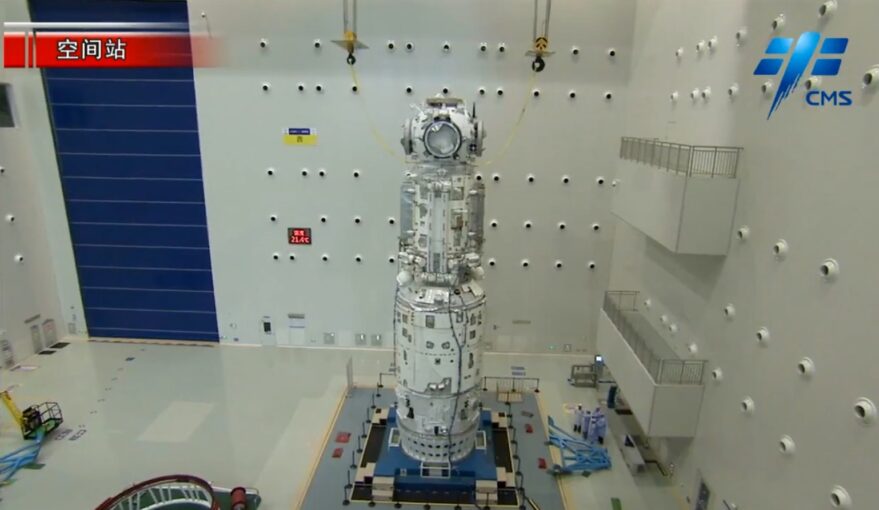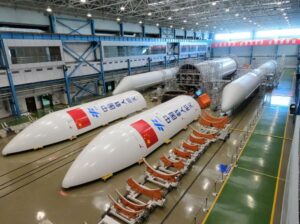The China Academy of Launch Vehicle Technology (CALT) is finalizing work on rockets which will launch the first space station module, a cargo and refueling craft and a crewed mission.
The launches will be the first of 11 planned missions to construct a three-module Chinese space station. The activity marks the beginning of the end phase of a project approved in 1992 to develop human spaceflight capabilities and establish a long-term crewed presence in low Earth orbit.
A 849-metric-ton Long March 5B heavy-lift rocket will launch the roughly 22-metric-ton Tianhe space station core module this spring. The launcher is currently undergoing final work in a factory in the northern port city Tianjin.
The rocket components will soon be transported by Yuanwang cargo ships to Wenchang Satellite Launch Center on the southern island of Hainan, according to CMSA, China’s human spaceflight agency.
A launch date has not been released but the mission will likely take place around two months after the arrival of the Long March 5B to Wenchang. Previous Long March 5 series missions have required such a period for launch preparations.
“We will soon complete the construction of China’s first long-term orbital crewed space station meeting advanced world levels, and will carry out large-scale space scientific research on it,” Zhou Jianping, chief designer of China’s human spaceflight program, told CCTV recently.
“We firmly believe that it will play a major role in the forefront of scientific exploration of humanity and also in the development of our space technology,” Zhou said.
Chinese space station launch, delays
Launch of the core module was planned for 2018 with subsequent modules to follow around 2020 and 2022. However a launch failure and subsequent issues with the Long March 5 rocket means China is now condensing the schedule into an intensive two-year period.
The 16.6-meter-long, 4.2-meter-diameter Tianhe core module was developed by the China Academy of Space Technology (CAST) and is already at Wenchang. It underwent fit checks with the first flight model of the Long March 5B, which features China’s largest payload fairing, in early 2020.
The module will provide the main living quarters for three astronauts for periods of around six months. It includes a docking hub and will also control the station’s orbit and attitude.

Tianhe is planned to be inserted directly into a low Earth orbit with an apogee of around 370 kilometers and inclined by 41 degrees. A test flight for the mission in April 2020 saw the first Long March 5B launch a prototype new generation crew spacecraft. The new, uncrewed craft was loaded with propellant to simulate a payload similar in mass to a space station module.
Notably the rocket’s large core stage reached orbital velocity and uncontrolled reentry off the west coast of Africa, passing over New York just minutes earlier. A similar event can thus be expected for the upcoming launch.
After completion in 2022 the Chinese Space Station will be joined by a co-orbiting, Hubble-class space telescope. The Xuntian survey telescope will be able to dock with the CSS for maintenance and repairs. The space station itself could also be expanded from three to six modules.
Cargo, crewed missions to follow
Once in orbit the Tianhe module will be visited by the Tianzhou-2 cargo spacecraft. This will be launched by a Long March 7 kerosene-liquid oxygen rocket from Wenchang. That launcher is currently undergoing final assembly.
Tianzhou cargo spacecraft have a mass of up to 13.5 tons and differing pressurized and unpressurized variants. Tianzhou-1 was launched in April 2017 to test technologies crucial to establishing and maintaining a space station.
The mission successfully tested a number of rendezvous and docking maneuvers and verified automated refuelling in microgravity with the Tiangong-2 space lab. The Tiangong lab also tested regenerative life support and a robotic arm for the larger, future space station.
This will be followed by the Shenzhou-12 crewed mission. This will launch on a Long March 2F, an older generation hypergolic rocket, from Jiuquan in the Gobi Desert.
It will be China’s first crewed mission since 2016. Zhou Jianping has previously stated that the crew have already been selected.
The astronauts are expected to carry out a number of extravehicular activities during the mission. The identity of the crew will likely remain secret until days or weeks before launch.
The Shenzhou-12 spacecraft will also feature an upgraded guidance, navigation and control system (GNC) to meet new mission demands, according to a 2017 report (Chinese).
The mission’s Long March 2F is undergoing testing in a final assembly facility in Beijing. Work is expected to be completed following the Chinese New Year (Feb. 12).
No clear schedule for the launches has been published. It is also unclear how soon after the two experiment modules will follow Tianhe into orbit. However the reports on launch vehicle preparations suggest the missions will follow relatively quickly after the module launch.
Chinese commercial resupply?
The Chinese Space Station, sometimes referred to as Tiangong (also the name for two small testbed space labs), is expected to be completed and enter normal operations in 2022 orbiting between 340-420 kilometers above the Earth.
CMSA announced Wednesday (Chinese) a solicitation for proposals for low-cost cargo transportation to assist space station operations.
The call aims to explore low-cost cargo transportation methods, create a supplement to the Tianzhou cargo delivery system, and build a “flexible, efficient, diverse, and low-cost cargo transportation system.”
Main requirements for cargo delivery include a payload capacity of 1-4 tons, possibility for removing and deorbiting station waste to prevent space debris, and transportation costs to be inline with international levels.
For returning cargo to Earth, requirements are for a payload 100-300 kilograms with the returning spacecraft to be easily tracked and recovered.
Actors are required to submit proposals by Feb. 28, including technical descriptions, spacecraft capabilities, and cost and engineering analyses.
The call is understood to be open to both state-owned space sector entities and new commercial actors, which have emerged since late 2014. The latter, nascent grouping is in the earlier phases of developing light and medium-lift launch vehicles and likely lack the required capabilities, expertise and resources.
The call for proposals is notable however for being open to outside entrants. Such missions and activities have so far been carried out by the China Aerospace Aerospace Science and Technology Corp. (CASC), China’s state-owned main space contractor.
Other actors such as sister conglomerate CASIC and nominally private firms were previously understood to be restricted to competing for commercial missions only. This indicates China is considering furthering commercialization of its space activities.



